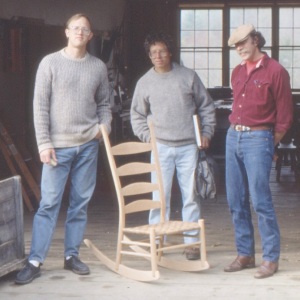Greenwood Chair-making
The “Bodging” Tradition

When Mike started making greenwood chairs in the 1980’s, he was mainly influenced by the tradition of the chair bodgers of the 19th century in the Chiltern Hills.

Here the tradition was for the bodgers to produce the turned components for Windsor chairs using freshly felled beech trees. The logs were transformed to shape by the techniques of cleaving, shaving and turning on a pole lathe. These components would then be dried and sold to chair-makers, usually based in urban workshops, who would often employ more specialists to shape the seats, bend the bows and assemble the chairs. It was unusual for one person to make a chair from start to finish.
American Traditions
In 1993 Mike attended a conference in the USA and was able to spend time with some of the leading American chair-makers, Jennie (John) Alexander, Drew Langsner and Brian Boggs who explored the tradition of ladderback chair-making around Kentucky and the Appalachian Mountains.

One particular technique was of particular interest as it actually made use of the fact that wood warps as it dries out. Far from being a drawback, this enabled the old chair-makers to form a slightly oval mortice-and-tenon joint, which increased the strength of the chair by enabling a tighter joint without splitting the wood. (These techniques are unique to the world of green wood chair-making and are described in detail in Mike’s books, “Living Wood” and “Going With The Grain”). Mike also learnt at first hand, the process of stripping the bark from certain trees to produce a flexible leather-like seating, unknown in the British tradition.
The Herefordshire Tradition

A year after his American trip, Mike moved to Herefordshire, with its tradition of ladderback and spindleback chairs, similar in many ways to the chairs he had seen in the USA. For the next ten years, Mike continued to make Windsor chairs but with an ever increasing interest in ladderbacks, especially the work of local Victorian chairmaker, Philip Clissett.

Compared to Windsor chairs with their solid plank seats and complex drilling angles, Herefordshire chairs involve fewer specialist operations, a smaller range of tools and eliminate the need for sawn planks. Mike has repaired and carefully examined a number of Clissett chairs and has developed a range of simple jigs which are used on his courses.
Making use of modern precision gauges, Mike has refined the oval joint, enabling beginners and experts alike to produce a comfortable, lightweight yet resilient chair without the need for glue.
From 2005, Mike ceased making Windsor chairs and his chair-making courses then concentrated on ladderback, spindleback and lathback chairs.
21st Century Innovation
Once one has learned the skills involved in using a pole-lathe, it is no doubt a quick, cheap and satisfying way to produce the components for a green wood chair. However it is an undeniable fact that it takes some time to develop a sufficient level of competence in the use of a pole-lathe. This is fine if one has time to devote to it, but on a 5-day chair-making course this can be a major drawback.

In the 1990’s a Canadian tool-maker called Veritas developed a variation on a traditional tool called a tenon cutter. Instead of the wood rotating against a chisel (as with a lathe) the work-piece is held firm and the cutting tool rotates. Together with the advances in cordless drills, the tenon cutter now enables the novice green woodworker to produce a perfect chair joint in a matter of seconds. This as they say, is a “no-brainer” and, since 2007, the tenon cutter has become one of the key elements in Mike’s chair-making courses. For those who want to construct their chair by person power, the tenon cutter can be operated in a traditional hand brace.

You must be logged in to post a comment.